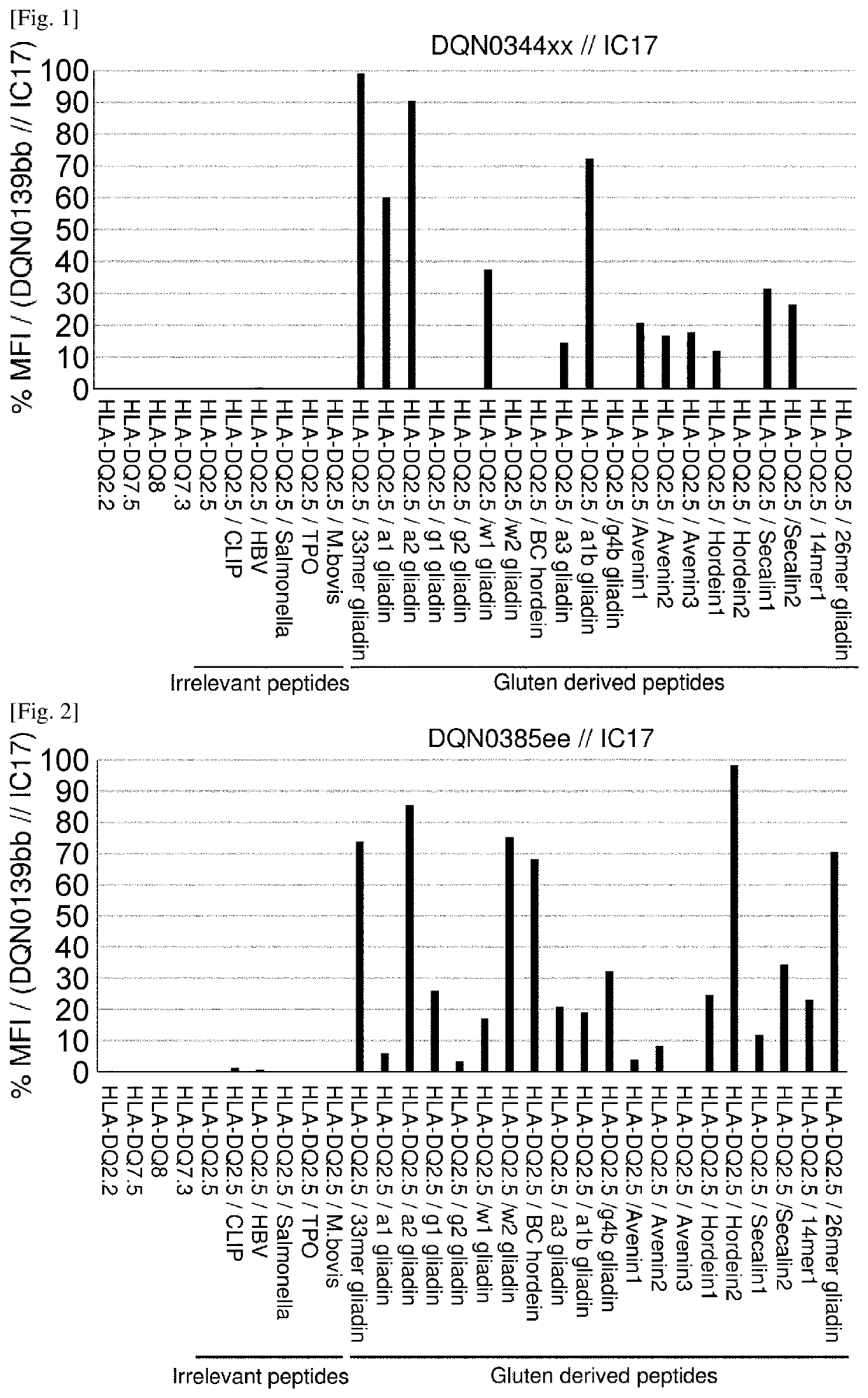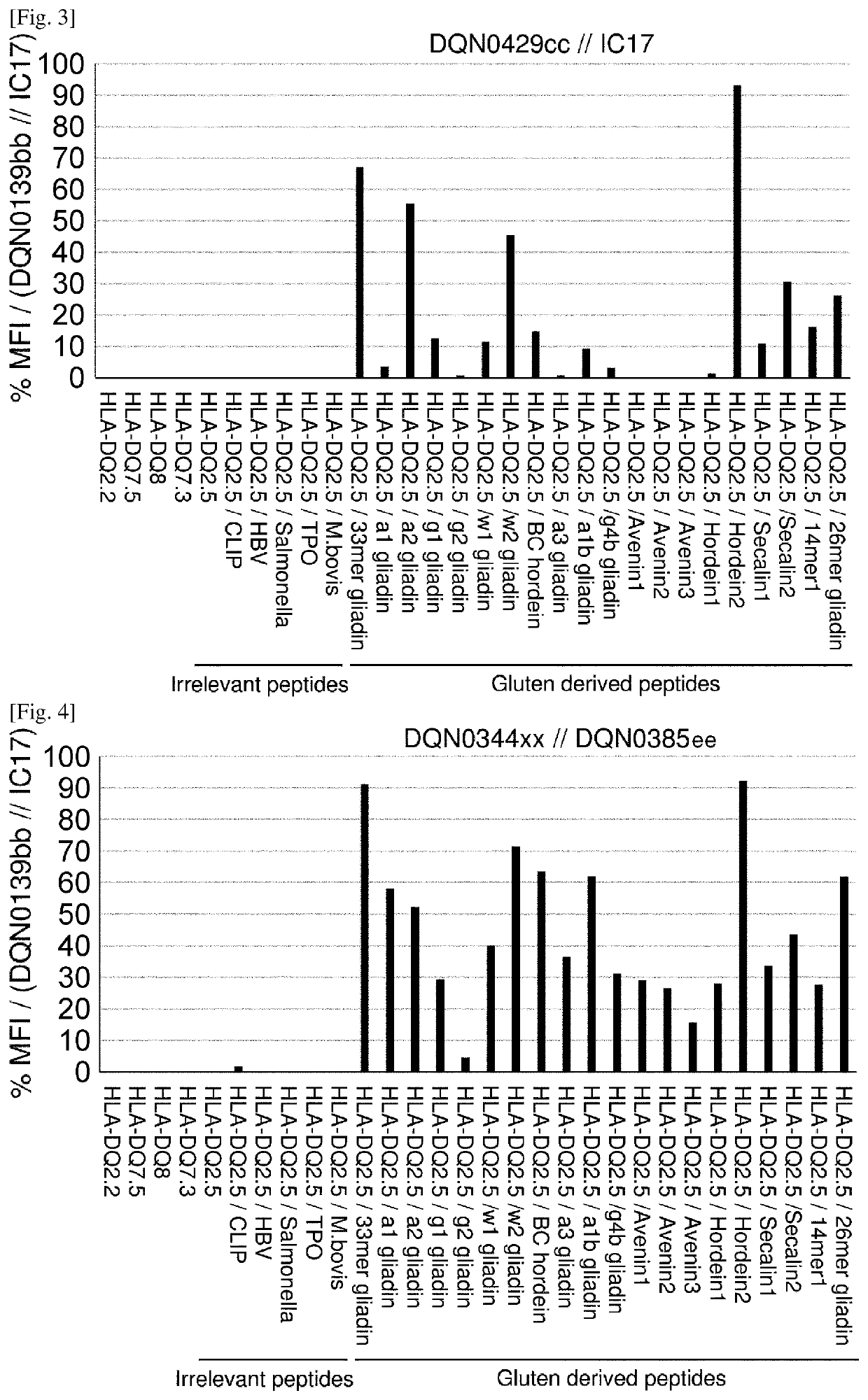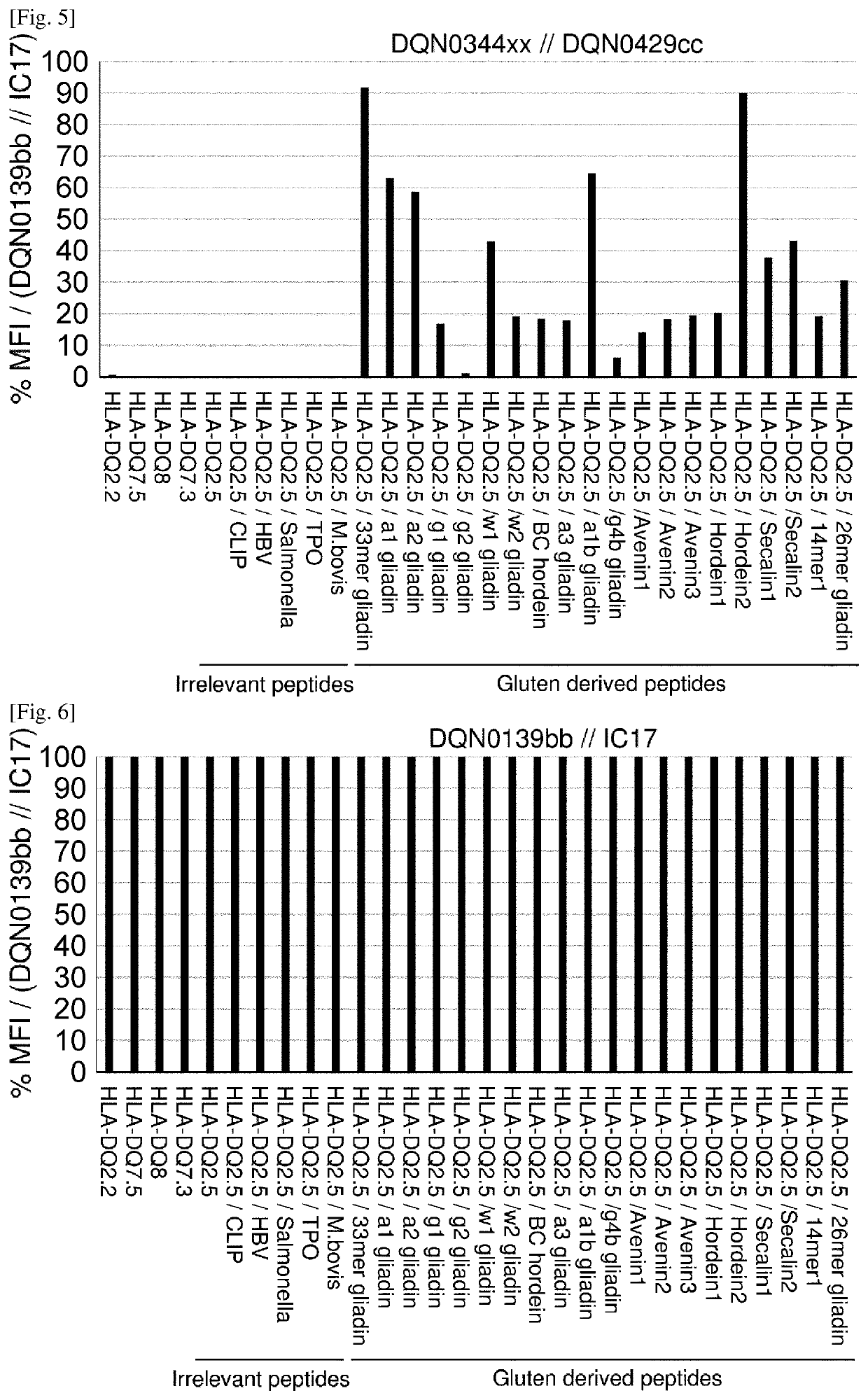Anti-hla-dq2.5 antibody
a technology of anti-hladq2 and anti-hladq2.5, which is applied in the field of anti-hladq2 . 5 antibodies, can solve the problems of difficult to completely eliminate gluten exposure, celiac disease symptoms, and no remarkable therapeutic advances achieved
- Summary
- Abstract
- Description
- Claims
- Application Information
AI Technical Summary
Benefits of technology
Problems solved by technology
Method used
Image
Examples
example 1
[0581]Expression and Purification of Recombinant Proteins
[0582]1.1. Expression and Purification of Recombinant HLA-DQ2.5 / 33mer Gliadin Peptide Complex, HLA-DQ8 / Gliadin Peptide Complex, HLA-DQ5.1 / DBY Peptide Complex,
[0583]HLA-DQ2.2 / CLIP Peptide Complex, HLA-DQ7.5 / CLIP Peptide Complex, HLADQ2.5 / Gamma 2 Gliadin Peptide Complex, and HLA-DQ2.5 / BC Hordein Peptide Complex
[0584]Expression and Purification of Recombinant HLA-DQ2.5 / 33mer Gliadin Peptide Complex:
[0585]The sequences used for expression and purification are: HLA-DQA1*0501 (Protein Data Bank accession code 4OZG) and HLA-DQB1*0201 (Protein Data Bank accession code 4OZG), both of which have a CAMPATH-1H signal sequence: MGWSCIILFLVATATGVHS (SEQ ID NO: 37). HLA-DQA1*0501 has C47S mutation, GGGG linker (SEQ ID NO: 38) and c-fos leucine zipper sequence (PNAS, 1998 Sep. 29; 95(20): 11828-33) and a Flag-tag on the C-terminus of HLA-DQA1*0501. HLADQB1*0201 has 33-mer gliadin peptide sequence: LQLQPFPQPELPYPQPELPYPQPELPYPQPQPF (SEQ ID NO:...
example 2
[0599]2.1 Establishment of D2 TCR-Expressing J.RT3-T3.5 Cell Lines
[0600]D2 TCR alpha chain cDNA (SEQ ID NO: 97) was inserted into the expression vector pCXND3 (WO2008 / 156083). D2 TCR beta chain cDNA (SEQ ID NO: 49) was inserted into the expression vector pCXZD1 (US2009 / 0324589). The linearized D2 TCR alpha chain—pCXND3 and D2 TCR beta chain—pCXZD1 (1500 ng each) were simultaneously introduced into J.RT3-T3.5 cell line by electroporation (LONZA, 4D-Nucleofector X). Transfected cells were then cultured in media containing Geneticin and Zeocin, after which sorting was performed to obtain a high-expressing cell population using AriaIII (Becton Dickinson). Single cell cloning was then performed to obtain cells that highly expressed the desired D2 TCR molecule.
[0601]2.2 Establishment of Ba / F3 Cell Lines Expressing HLA-DQ2.5, HLA-DQ2.2, HLADQ7.5, HLA-DQ8, HLA-DQ5.1, HLA-DQ6.3, HLA-DQ7.3, HLA-DR, and HLA-DP
[0602]HLA-DQA1*0501 cDNA (IMGT / HLA accession No. HLA00613), HLADQA1*0201 cDNA (IMGT / H...
example 3
[0607]Generation of Anti-DQ2.5 Antibodies
[0608]Anti-DQ2.5 antibodies were prepared, selected and assayed as follows: NZW rabbits were immunized intradermally with the HLA-DQ2.5 / 33mer gliadin peptide complex. Four repeated doses were given over a 2-month period followed by blood and spleen collection. For B-cell selection, a biotinylated HLA-DQ5.1 / DBY peptide complex, biotinylated HLA-DQ8 / gliadin peptide complex, and Alexa Fluor 488-labeled HLA-DQ2.5 / 33mer gliadin peptide complex were prepared. B-cells that can bind to HLA-DQ2.5 but not HLA-DQ5.1 or HLA-DQ8 were stained with the labeled proteins described above, sorted using a cell sorter and then plated and cultured according to the procedure described in WO2016098356A1. After cultivation, the B cell culture supernatants were collected for further analysis and the B-cell pellets were cryopreserved.
Specific binding to the HLA-DQ2.5 / 33mer gliadin peptide complex was evaluated and non cross-reactivity to the HLA-DQ5.1 / DBY peptide compl...
PUM
| Property | Measurement | Unit |
|---|---|---|
| concentrations | aaaaa | aaaaa |
| concentrations | aaaaa | aaaaa |
| concentrations | aaaaa | aaaaa |
Abstract
Description
Claims
Application Information
 Login to View More
Login to View More - R&D
- Intellectual Property
- Life Sciences
- Materials
- Tech Scout
- Unparalleled Data Quality
- Higher Quality Content
- 60% Fewer Hallucinations
Browse by: Latest US Patents, China's latest patents, Technical Efficacy Thesaurus, Application Domain, Technology Topic, Popular Technical Reports.
© 2025 PatSnap. All rights reserved.Legal|Privacy policy|Modern Slavery Act Transparency Statement|Sitemap|About US| Contact US: help@patsnap.com



